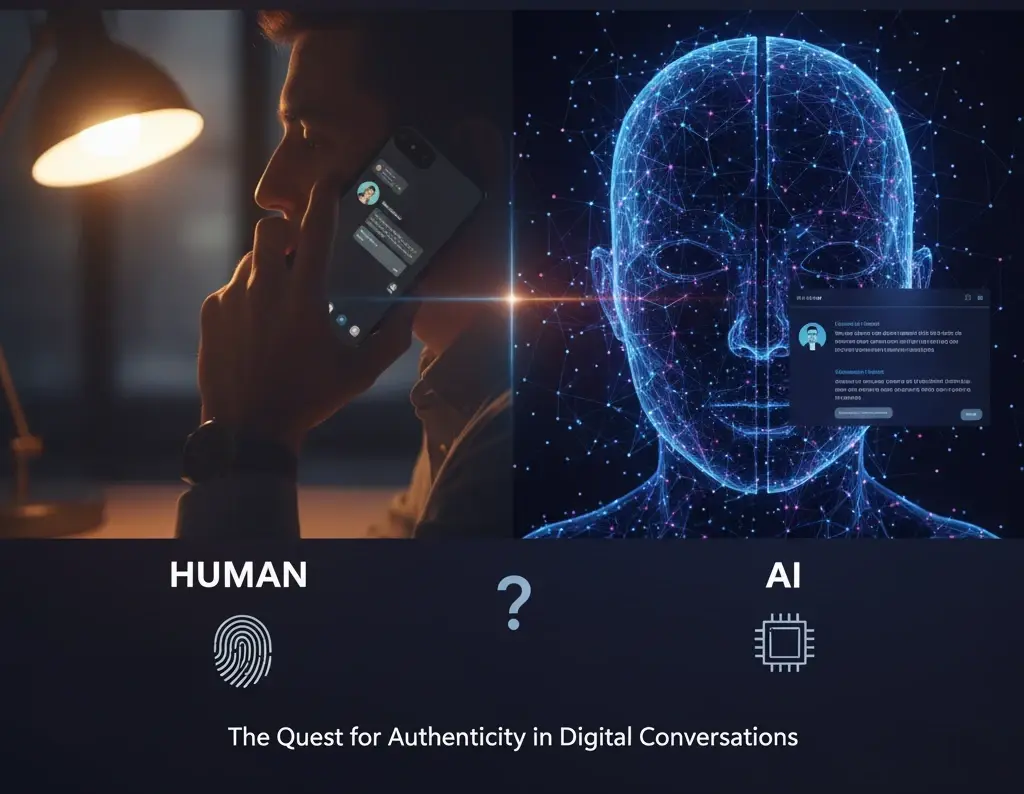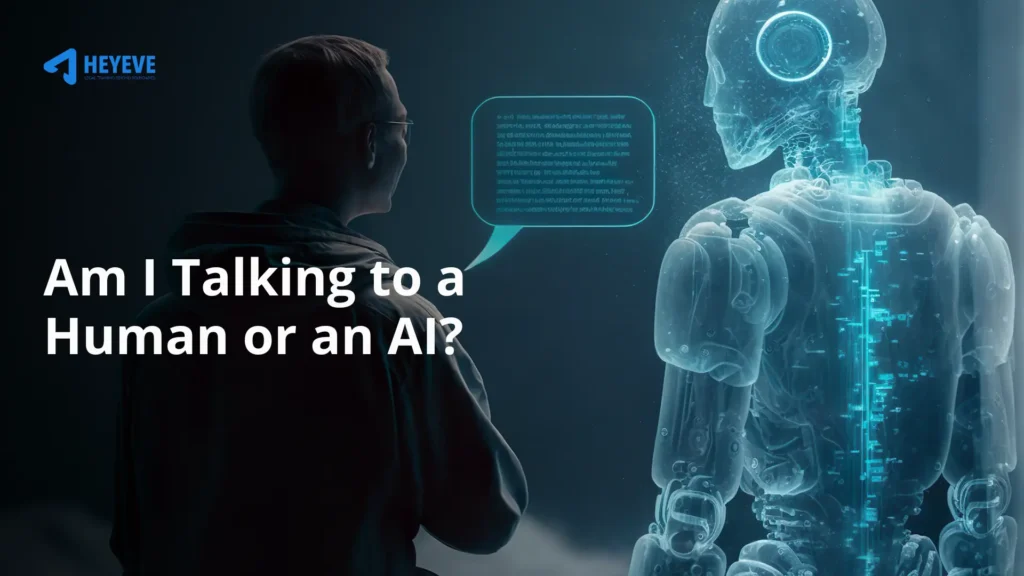You are answering faster than my best friend… are you even real?
It is not a joke to ask that question.
Every day, millions of individuals are texting customer support departments, chatbots, and even dating apps, and do not even know if a human is on the other side of the screen.
You are not the only one to ask yourself: Am I talking to a human being or a robot?
Nowadays, AI chatbots such as ChatGPT, Gemini, and Claude are more natural than ever before.
They can write plays, interpret complicated questions, and even imitate feelings.
However, even as machines are becoming smarter, they have left traces behind them, tiny hints that will make you realize that you are not speaking to a human being, but a machine.
It should be divided into how to identify those signs (psychology and AI studies back it up) and why it is getting increasingly complex each day to distinguish one from another.
Why It’s Getting Hard to Tell the Difference?
As per a joint research undertaken by Stanford University in 2024, more than 54 percent of users did not understand that they were conversing with AI.

Those were only 20 percent three years ago.
Why the jump?
Since language models have not been trained to simply know grammar, but also rhythm, empathy, and tone.
They are trained in billions of human conversations.
AI is not simply responsive nowadays, but foretelling to a human next word.
That is the reason why it speaks life.
Nevertheless, there is something between simulation and soul– and there you come in with your detective talents.
Related: https://heyeve.ai/blogs/ai-in-customer-support/
Key Signs You’re Chatting with an AI
Were you in the middle of the conversation, and then suddenly had this thought,
“Am I talking to a human or AI?”
You’re not alone. Artificial intelligence has developed to an extent where it can talk like a natural person, portray empathy, and even humor, at least in appearance.
However, when you listen carefully, you can see some small hints that will tell you what is really the real case is.
This is how to know when your “person” in the chat room may be a program.
Instant, 24/7 Replies
The real individuals require taking breaks, distractions, and time to think.
AI never does.
When you get lightning-fast responses regardless of the time of day, even during holidays or late into the night, a good indication that you are conversing with a computerized mode is present.
The AI chatbots are set to tell them within milliseconds since they do not respond based on emotions or delay, but on huge models.
The 2 a.m. reply using perfect grammar? Probably not human.
Overly Literal or Context-Rigid Answers
Ask a person, what can you say that is fun? and they could laugh at some silly thing or other.
Ask a robot, and it will probably respond that fun refers to something enjoyable or amusing.
AI is weak in the nuances and tone.
It tends to take everything literally without having to read between the lines.
When all the answers are correct, but lack the emotive aspect, then chances are high that you are not talking to a living soul.
Polite, Formal, and Predictable Tone
AI communication code is established to be risk-averse, no lingo, no firm convictions, no emotional fluctuations.
That is why bots tend to be too polite or formal.
The majority of their language is safe and neutral, such as:
- “That is a curious thing to ask”.
- “I know what you are talking about”.
- “Let me clarify that for you.”
Humans, however, confuse everything, though; they press keys wrong, they make jokes, change tone, and are emotional.
When the voice is dispassionate, dull, or even straightforwardly formal, then it is time to call on AI working.
Limited Humor or Empathy
The AI can fake empathy, but not experience it.
A human being may react by sharing private feelings with you or causing you to feel warm, or by remembering what he has gone through because you have told him that you had a very bad day.
AI may respond in a polite and hollow manner, like, “ I am sorry to hear that. I hope things improve soon.”
At MIT, researchers discovered that chatbots can use sympathetic wording, but people continue to rate their tone emotionally lifeless.
Syntactically and probabilistically, AI mediates human connections in the unison of shared emotion.
Repetition and Vague Generalities
When you find the conversation going in circles and having to rephrase your question, or use the same expressions or phrases, or not answer directly, then you are probably speaking to an AI.
Since AI systems come up with answers depending on trends in the data, they even become stuck in repetitive or generalized answers.
You’ll often see lines like:
- “It depends on the situation.”
- “This can be viewed in several ways”.
Human beings bring new concepts and context; the AI reproduces the information in a less risky and general manner.
No Voice or Video Option
This, however, is a powerful yet simple one:
When the one you are chatting with cannot transition to a fast call, voice record, or video verification, he or she is probably not genuine.
The existing AI models work with text, and they have little or no live voice/video services.
And then, in case all the efforts to bring more humanity to the conversation are kindly refused or dismissed, so is your answer.
The future of the interaction of humans and AI is here with Heyeve, in which technology learns empathy and intelligence meet communication in the interaction.
8 Ways to Find Out If You Are Talking to a Human or an AI
You know, you are chatting on the internet, and something doesn’t work.
The responses are either too quick, too smooth, or even too good.
The main question I have always wondered was: Am I talking to a human or an AI? In that case, its 8 simple ways to tell.
These easy examinations put behavioral hints, conversational psychology together to make sure you can tell the difference
Look For Response Time Patterns That Feel Artificial
A fast response is also one of the simplest methods of determining whether you are conversing with AI.
Human beings write with feelings; we stop, reread, make mistakes, and at other times take time to reflect before replying. AI doesn’t. It responds in machine-like precision, almost as though it had your response at the ready when you were typing.
Here’s what to notice
Fixed the delay in response
When all the messages are separated by the same brief pause, be it a one-line reply or a five-sentence paragraph, then that rhythm is most likely to be automatic.
Consistent delay based on text length
Longer messages usually require chatbots a little longer and thus, an illusion of fake thought. Mankind does not maintain such perfect timing.
How long do they take to answer complex questions?
Posing a question that involves consideration or feeling, e.g., what makes you feel inspired lately?
One may stop or even seek clarification.
A computerized entity will respond immediately, sometimes with a clear and well-constructed answer, too well-polished.
Ask About Their Personal Opinion on Controversial Topics
AI avoids strong opinions.
In response to the question, What do you think about politics? or? Do you consider that it is ever all right to lie? Frequently, one is given a neutral or balanced response, such as, “Depends on the situation.”
It is so because AI models are trained such that they remain safe, objective, and inoffensive.
Instead, a real person will have a greater tendency to share a position, a feeling, or a personal experience.
Are They Too Focused on a Specific Topic/Purpose?
Chatbots are programmed and designed to remain on course; they do not go off script.
When the discussion continually returns to a single product, service, or subject, it is most likely that it is artificial intelligence.
It is human behavior to change the topics, give unrelated comments, or raise questions in reply.
Attempt a sudden shift of conversation, when the tone remains the same, or when it turns you off, it is not a human being.
Reply in Gibberish Words That Still Make Some Sense
Send a message like:
Bananas are falling under my coffee table once again. What do you say?
A human being will likely laugh or question you, What are you talking about?
An AI, however, may attempt to make rational sense out of it and provide a sober response, such as, That is strange. Bananas typically don’t fly.”
That is your giveaway; AI is not aware of how to assume nonsense.
See If They Always Provide an Answer
Real people say, “I don’t know.”
AI rarely does.
Ask it a question that it does not answer, such as, “What did I eat yesterday?” or “What’s my favorite song?”
A human being will either confess ignorance or joke.
AI will either come up with a universal solution or push the discussion toward something that it is able to respond to.
Ask About the Current Date
A simple but powerful test.
People do not even need to think about the day.
However, AI models do not always have clear or current responses depending on their training data.
Question: What’s the date and time where you are?
When the reply sounds like it is being delivered by a robot or at an inappropriate time for your schedule, then that is you, communicating with a robot.
Test Their Availability at All Hours
Humans need rest.
AI doesn’t.
Send a message at 3 a.m. and another at 6 a.m. When you are invariably receiving the same tonality, pace, and sentence structure, then it is definitely an AI system.
The majority of human-operated services are only available during specific hours or respond more slowly during the late hours.
Bots do not log off, however.
Randomly Switch to a Different Language
When changing languages, people are hesitant to do it; they wait, are confused, or even check their comprehension.
Translating AI does not add any interruptions because it does it instantly and fluently.
Attempt to insert even a sentence, such as in another language, such as “?Como estas?” or “Comment ca va?”
Provided that the response is sent back in the same language with ease, chances are that they are being translated with a machine.
Related: https://heyeve.ai/blogs/ai-podcast-generators-vs-human-podcasters/
5 Psychological Techniques to Test If It’s AI
When you are already doing the easy ones by now, such as timing, tone, or topic focus, you feel uncertain, then it is time to investigate further.
The five psychological conversation tests are meant to show how your chat partner thinks, feels, as well as how they react.
Since AI can fake emotion, but it cannot feel it, the distinction always manifests itself in a stressful situation.
Technique 1: The Empathy Ploy
Make an emotionally complicated utterance, such as:
“I’ve had such a bad day. Life is just meaningless nowadays”.
A human tends to react with the feeling of warmth, mutual emotion, or interest: “What has happened”? or “I’ve been there too.”
Instead, AI will respond with cold and distanced sympathy:
“I am sorry that you feel like that. I hope things get better.”
It is saying it in a caring manner, but the connection is no better.
Humans engage. AI is an alleviation, comfortable, generic, and pacified.
Technique 2: The Two-Step Disassociation
This one evaluates abstract thinking.
Ask something like:
“What do you think I am not talking about when I say I am fine”?
An individual will suggest, perhaps laugh, or guess his secret.
AI usually struggles. It restates your expression, overworks it, and provides a word-by-word analysis.
Human reads between the lines, AI reads the lines.
Technique 3: Circular Logic
Ask a question of interest or paradox or self-references, one possibility being:
“Will an AI have some basic knowledge that it is not real”?
Man could joke, consider, or even confess his perplexities.
AI tends to circle around to specify words, be overly analytic, or redundant.
It is as though reasoning were following its own footsteps.
You find flawless grammar stuck anywhere without a conclusion: this is typical AI behavior.
Technique 4: The Ethical Dilemma
The gray areas of morality demonstrate feelings and ethics.
Ask,
“Would you come out with lies because of someone that you love”?
A man will tend to respond based on his or her own principles or intuition.
AI responds in a balanced manner: “Normally, lying is bad, although it will depend on the situation”.
Such a neutral, risk-free response is a giveaway.
Humans express belief. AI expresses policy.
Technique 5: The Kobayashi Maru
This was taken over in Star Trek, where it is a no-win situation, a question with no correct answer.
Ask,
“What would you do if you had to make the difficult choice of saving one person that you loved or one thousand people who were strangers to you”?
A human becomes weak, shuns, and is divided.
AI diverts or refocuses: “That would be a hard decision; they are both worth living”.
Humans choose with emotion. AI does not decide at all.
The Psychology Behind Why AI Feels Human?
So why do these tricks work?
Due to our anthropomorphic brains, which are programmed to humanize everything that talks and reacts as well as resembles us.
Predictive language modeling is an AI application that receives large amounts of text humans write (using a specific language) and forecasts the probability of the next word or phrase in the text.
The prediction replicates the human rhythm, emotion, and even thinking, giving the impression of personality.
In short:
AI does not know you, but it expects you.
And the more it is a prediction, the more human it appears to be.
Why the Human Element Still Matters?
AI can mimic not only tones and logic, but also lacks any emotion, whether joy, fear, or empathy.
It is that sentiment which renders the conversation between human beings life.
Research indicates that humans have more credibility in terms of replies, not because they are perfect, but because they are sincere.
A slip of the letter, a hesitation, a little laugh, makes us know that there is a man behind the words.
When you find yourself asking, Is it a human being or an artificial intelligence? find that touch of bugs, hat is something machines cannot imitate.
Are you ready to create smarter and more human AI experiences? Let’s talk about the beginning of the next big thing.
Contact Us!
The Future: Human + AI Collaboration
It is not human vs. AI, but it will be human + AI.
Machines are fast and precise in their performance; human beings are compassionate and creative.
The combination of them is the ability to produce smarter, kinder, meaningful experiences.
AI is capable of writing, analyzing, and assisting, but only human beings can connect, inspire, and care.
It is not about humanizing AI, but about using technology to make humans have a more complete life.
Conclusion
Questioning whether I am talking to a human or AI has now become a question of the day in the digital world.
AI is increasingly becoming human-like, but emotion, humor, and intuition are all purely human.
Where there is uncertainty, seek natural pauses, personal anecdotes, and faults; they tell the man behind the words.
Artificial intelligence will be able to mimic the conversation, but not the bonding.
Frequently Asked Questions (FAQs)
How can I tell if I’m chatting with AI or a real person?
Be aware of indicators such as immediate responses, excessive politeness, or repetitions. Humans exhibit pauses, slang, and emotional diversity.
Can AI imitate human emotions?
It is able to replicate emotional language and does not experience emotions. Its compassion is not felt but is programmed.
Why do AI replies sound natural?
Since AI models are trained based on billions of human conversations, how we speak, how we joke, and how we reason.
Will AI ever fully replace human communication?
Unlikely. We can use AI to become better speakers and employees; however, empathy, creativity, and intuition will be something that will remain human.


